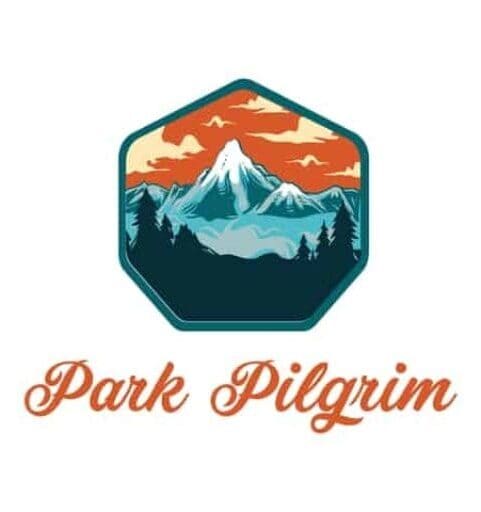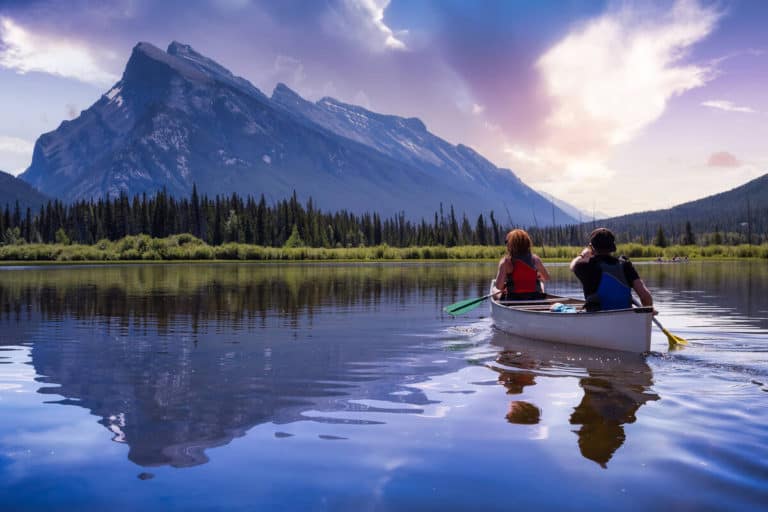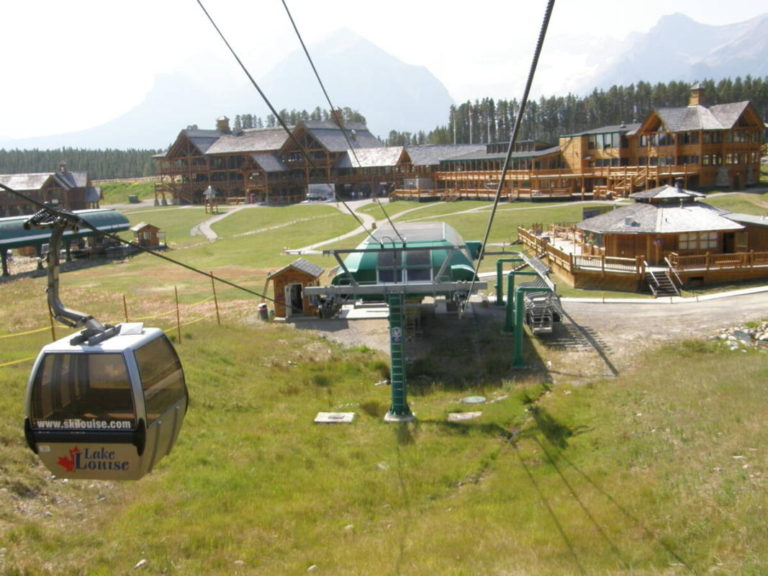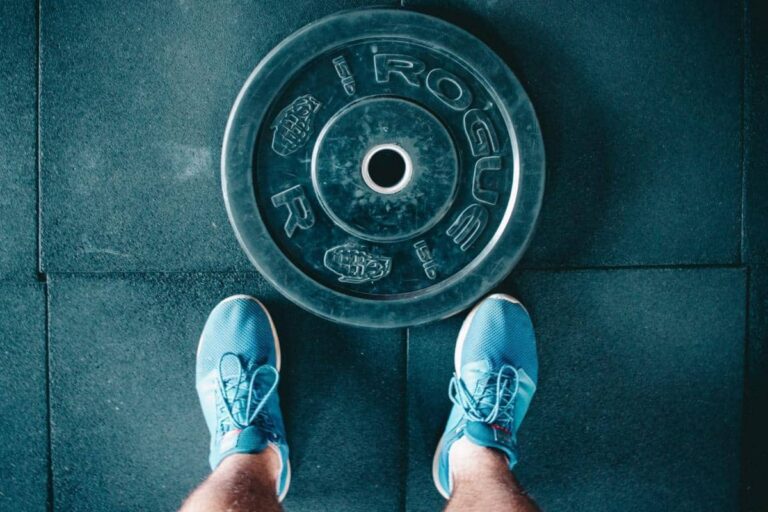Banff Springs vs. Château Lake Louise: Battle of the Fairy Tale Castles
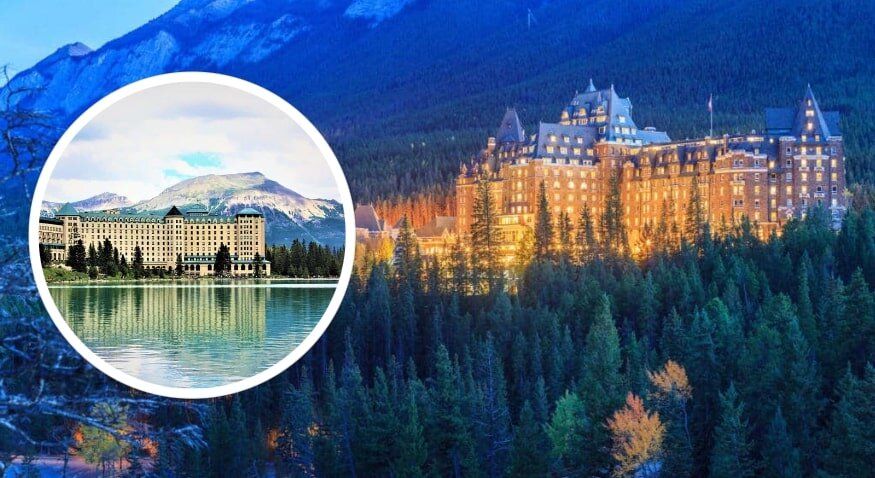
Let’s be real here — if you’re planning a trip to the Canadian Rockies and have a taste for luxury, you’re probably torn between two iconic Fairmont properties: Banff Springs Hotel and Château Lake Louise. I just spent way too much time researching both, and one thing’s for sure: it’s not as simple as picking the prettier castle.
These two legendary hotels sit like crown jewels in Banff National Park, but they offer surprisingly different experiences. And you know what’s funny? Most travel sites just tell you ‘they’re both amazing!’ without getting into the nitty-gritty of what actually matters when you’re dropping serious cash on a Canadian mountain getaway.
So let’s cut through the marketing fluff and celebrity endorsements. Here’s what actually separates these two grand dames of the Rockies!
This post contains affiliate links and any sale made through such links will reward this site a small commission – at no extra cost to you
CHECK PRICES AND AVAILABILITY
Location, Location, Location
The biggest difference between these hotels isn’t about thread counts or spa treatments — it’s where they sit.
Fairmont Banff Springs Hotel perches on a forested hill above the town of Banff. It overlooks the meeting point of two rivers. It’s that classic ‘castle in the mountains’ you’ve seen in a million photos. And yes, it genuinely looks like something out of a European fairy tale.
You’re about a 20-minute walk from downtown Banff, where you’ll find restaurants, shops, and bars.
Château Lake Louise, on the other hand, sits directly on the shores of that famously turquoise lake you’ve seen all over Instagram.
This location is more remote — you’re basically at the end of the road, surrounded by mountains and glaciers, with the tiny village of Lake Louise about 4 kilometers (2.47 miles) away (and trust me, there’s not much there).
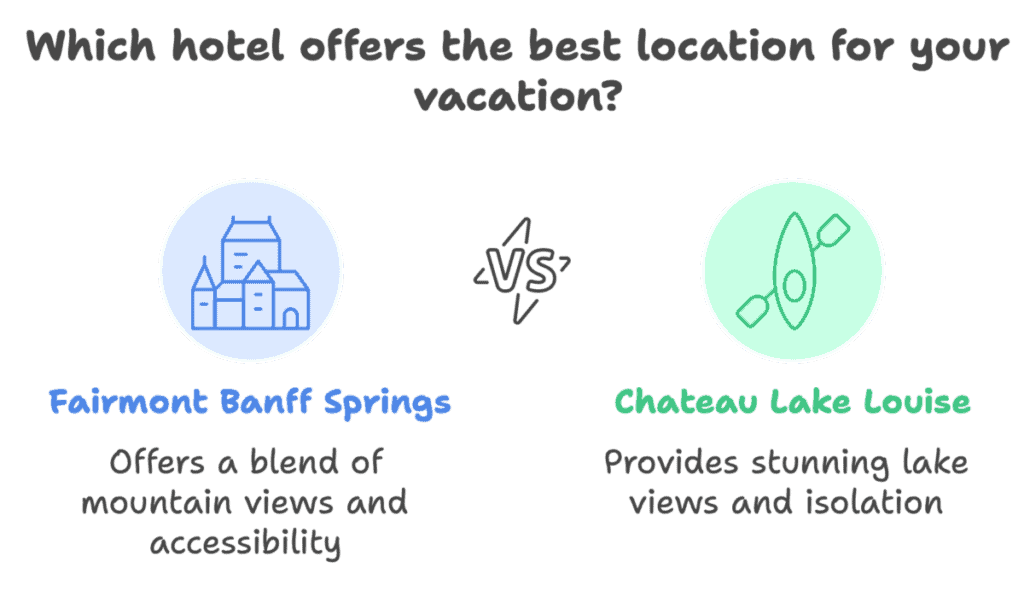
Here’s the thing: at Lake Louise, the jaw-dropping view is your entertainment. You wake up to it, you dine with it, you can literally walk out the door and be standing at one of the most photographed spots in Canada.
It’s hard to oversell just how spectacular this setting is — it makes Banff Springs’ already stunning location seem almost ordinary by comparison.
The tradeoff? You’re pretty much stuck at the hotel unless you want to drive 45 minutes back to Banff for other options. Some love this isolated luxury; others get cabin fever after a day or two.
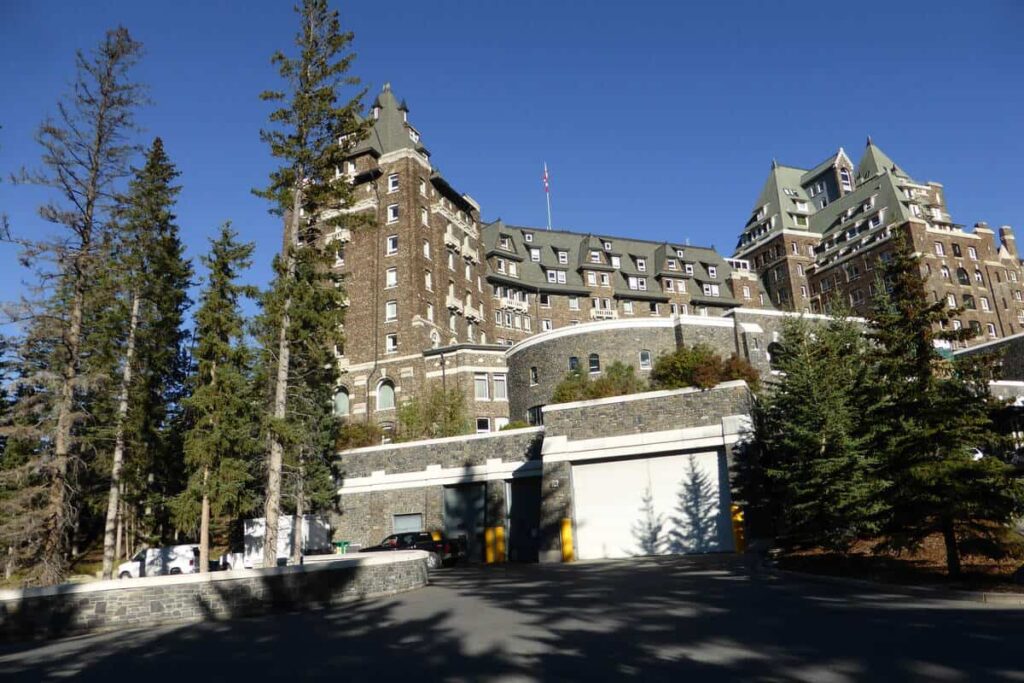
The Vibe: Bustling Castle vs. Serene Retreat
These hotels might share a corporate parent and alpine styling, but the atmospheres couldn’t be more different.
Banff Springs is massive — we’re talking 764 rooms spread through endless corridors and wings. It has the energy of a small, bustling village including its own shopping mall.
During peak season, you’ll share the space with conference attendees, wedding parties, tourists just stopping by to see the famous building, and families bowling in the hotel’s arcade. It’s lively! There’s always something happening.
The Château has a more intimate, exclusive feel despite its 539 rooms. During the day, it gets busy with day-trippers coming to see Lake Louise, but once evening falls and the tour buses leave, this place transforms
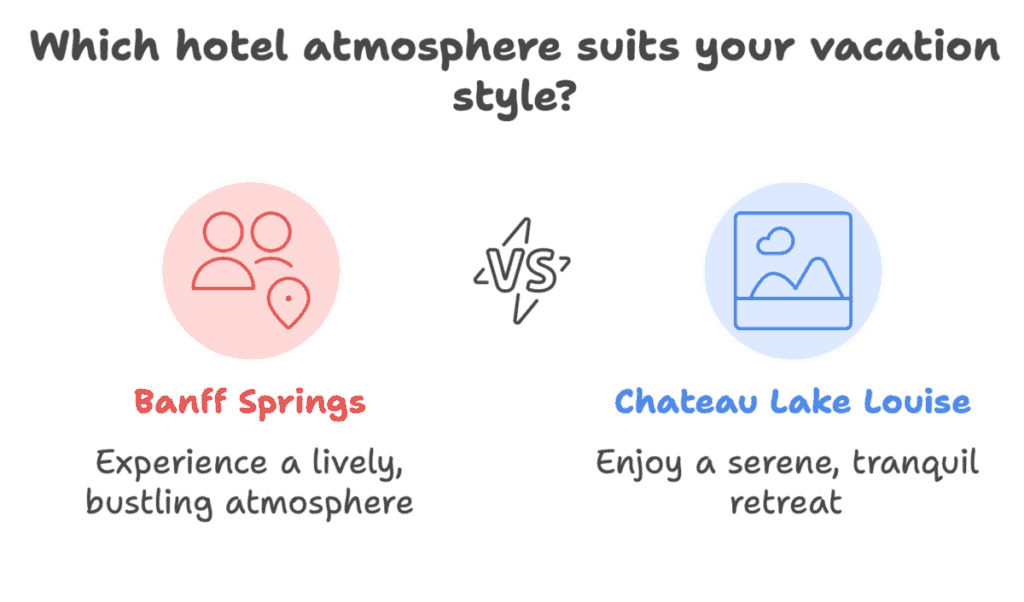
You’re left with hotel guests enjoying a quiet, almost reverent atmosphere as the alpenglow hits the surrounding peaks. The isolation creates this bubble of tranquility that you just don’t get at Banff.
Maybe you know that both properties have that classic ‘château’ architecture with the pointy roofs and grand lobbies.
Banff Springs leans harder into its Scottish baronial castle vibe with dark woods and old-world gravitas.
Lake Louise offers a slightly lighter, airier take on the same theme, with its public spaces designed to showcase that incredible view.
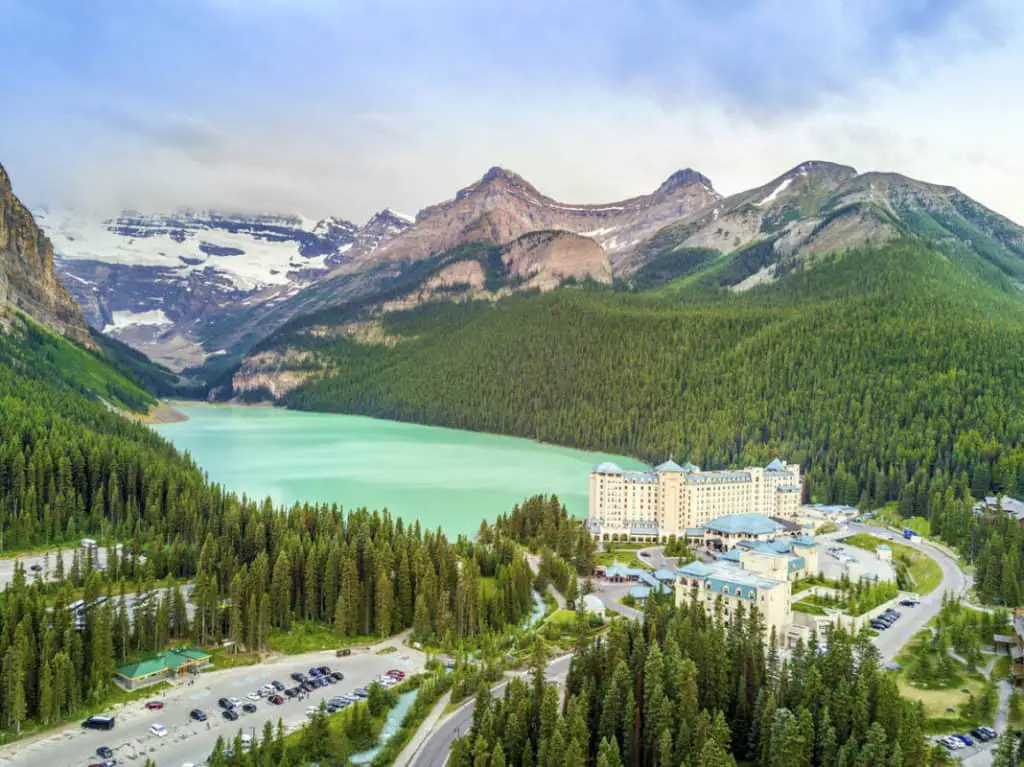
Room Reality Check
Let’s be honest about the rooms: at both hotels, you can end up with something surprisingly small and dated if you book the base-level accommodations. These are historic properties, after all, not gleaming modern towers.
And let’s face it, we Americans and Canadians have never been the best at interior design…
At Banff Springs, some of the entry-level ‘Fairmont Rooms’ are legitimately tiny — 18 square meters (around 200 square feet). You’re paying for the privilege of staying in a historic building, not for square metrage.
And while they’ve renovated most rooms between 2021-2024, some still have quirks like small bathrooms or limited air conditioning.
Lake Louise rooms follow the same pattern. Their standard rooms aren’t exactly spacious either, though they’re currently in the middle of a massive renovation (2023-2025) that’s modernizing everything.
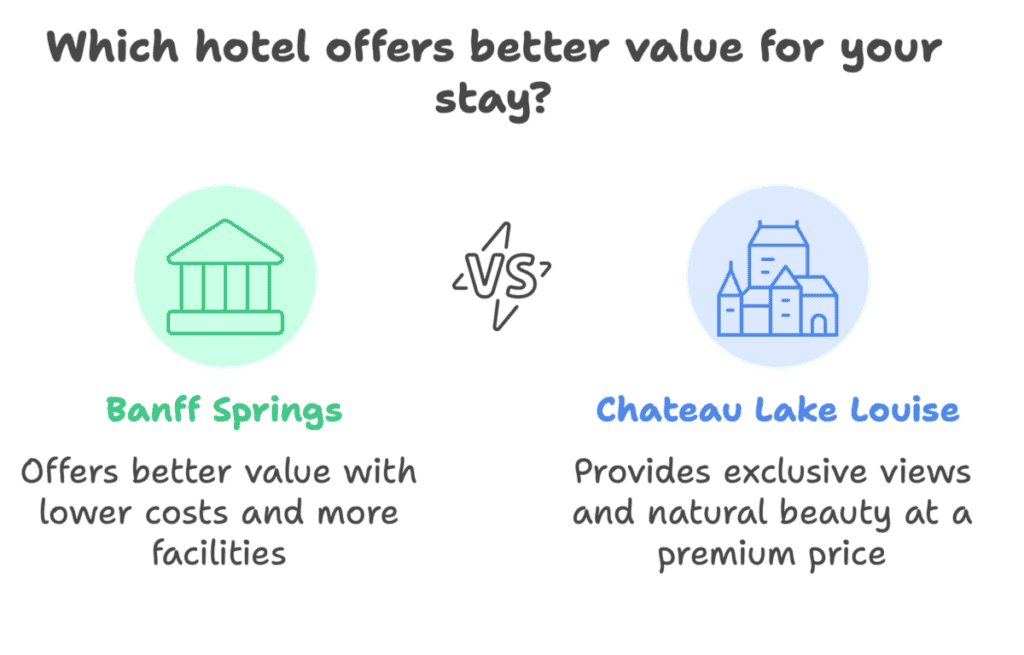
The real differentiator here is the view — a ‘Mountain View’ room is nice, but a ‘Lakeview’ room is the whole point of staying here, and you’ll pay dearly for the privilege.
Both hotels offer Fairmont Gold floors with private check-in, dedicated lounges, and included breakfast. It’s essentially the club level, and frequent guests swear it’s worth the substantial upcharge, especially at Lake Louise where the Gold service reportedly edges out Banff’s.
But let’s be real here — neither property is a great value proposition if you’re just looking at the rooms. You’re paying for the experience, the location, and the bragging rights.
CHECK PRICES AND AVAILABILITY
Food Fight
For a foodie, Banff Springs is the clear winner. The hotel houses 12 restaurants and bars, ranging from a high-end steakhouse (1888 Chop House) to a quirky fondue spot in a converted hunting cabin (Waldhaus) to casual sushi and brasserie options. You’ll never run out of choices, though you might run out of money — prices are predictably steep.
Château Lake Louise has fewer options (7 restaurants/lounges), but what they lack in quantity they make up for with that million-dollar view. Dining at the Fairview or Lakeview Lounge means scoring a table overlooking the turquoise waters, which transforms an ordinary meal into something memorable.
They’ve recently renovated some dining venues too, including adding a new Mediterranean restaurant called Louiza (formerly Poppy Brasserie).
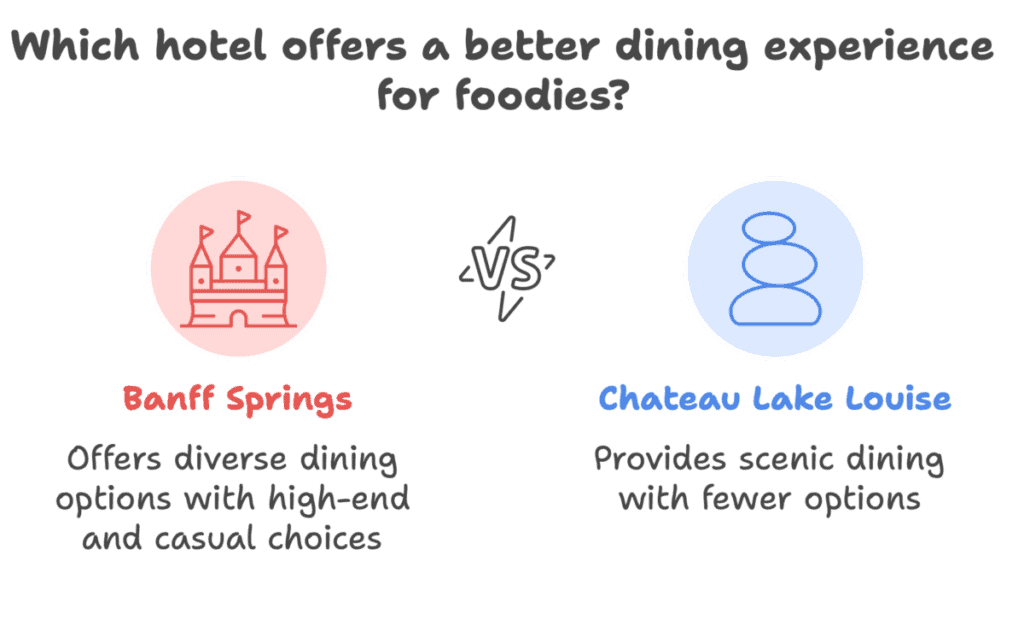
The truth is, food at both properties gets generally high marks for quality but low marks for value — you know, typical luxury hotel pricing. The difference is that if you’re staying at Banff Springs, you can easily escape to town for other options. At Lake Louise, you’re pretty much committed to hotel dining unless you want to drive.
Oh, and Lake Louise gets bonus points for its seasonal ice bar in winter — literally a bar carved from lake ice where you can sip cocktails while bundled up against the cold. You gotta admit, that’s pretty cool (sorry, couldn’t resist).
Activity Overload
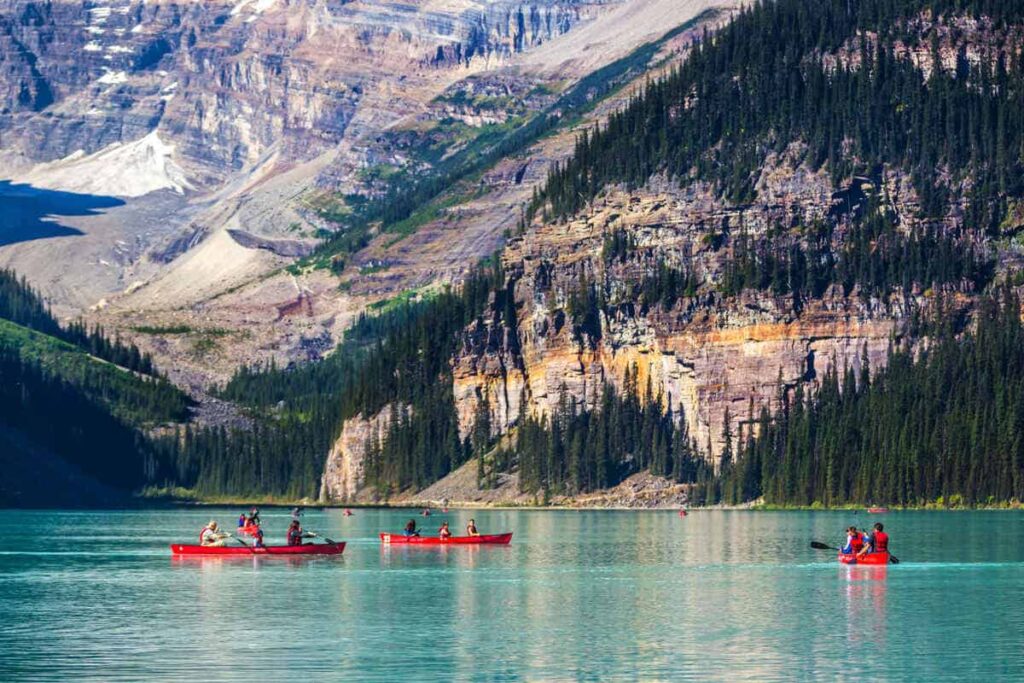
Here’s where your personal preferences really matter. Both hotels offer an embarrassment of riches when it comes to outdoor activities, but with different emphases.
Banff Springs positions itself as the ultimate four-season resort.
In summer, you’ve got an 18-hole championship golf course right on property, complementary bike rentals, hiking trails from the door, and easy access to all of Banff’s activities.
Winter brings proximity to three different ski resorts (Mount Norquay, Sunshine Village, and Lake Louise) with shuttle service, ice skating, and sledding options.
Inside the hotel, there’s bowling, an arcade, swimming pools (including a year-round outdoor heated pool), and regular programming like historical tours of the ‘castle’. And remember, you’re close enough to town to enjoy Banff’s museums, shops, and nightlife.
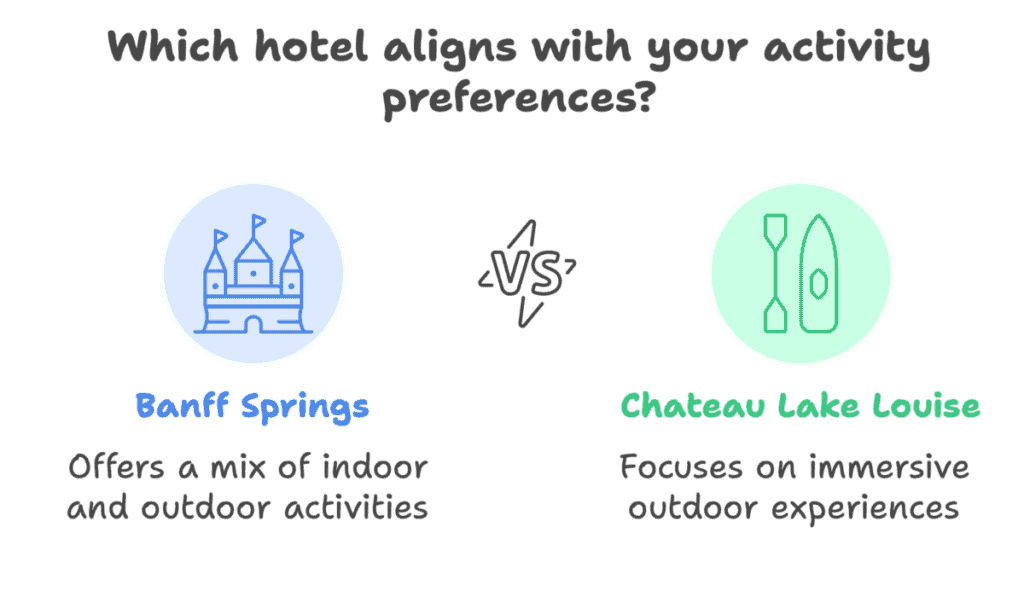
Chäteau Lake Louise obviously is all about that lake. In summer, hotel guests get priority access to canoe rentals, including exclusive sunrise paddles before the day-trippers arrive. Famous hiking trails start right at the hotel’s doorstep, including routes to the Lake Agnes Tea House and Plain of Six Glaciers.
Winter transforms Lake Louise into a magical ice kingdom. The hotel maintains a skating rink on the frozen lake, complete with ice sculptures and sometimes a full ice castle.
Horse-drawn sleigh rides skirt the shoreline, and the proximity to Lake Louise Ski Resort (just 5-10 minutes away) makes this a skier’s paradise.
The difference? Banff Springs offers more variety and structured entertainment; Lake Louise offers deeper immersion in nature’s playground. At Banff, you might split your time between outdoor adventures and indoor luxuries; at Lake Louise, you’re going all-in on the outdoor experience, with the hotel as your plush base camp.
Spa Wars
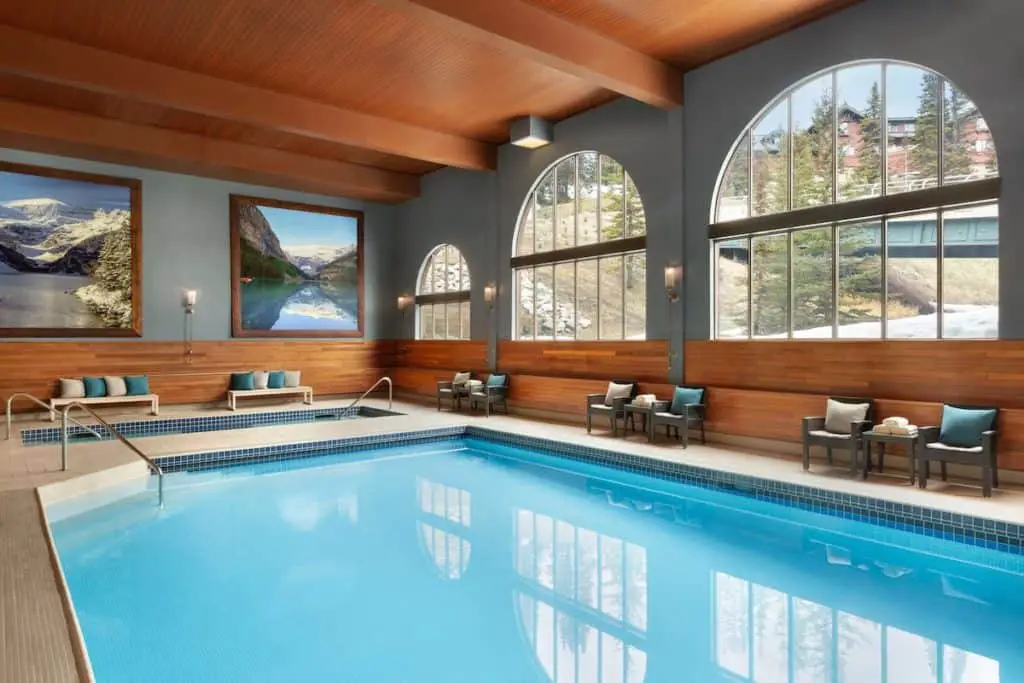
Both hotels boast impressive spa facilities, but Banff Springs’ Willow Stream Spa is the heavyweight champion here.
Spanning 3,530 square meters (38,000 square feet), it features multiple mineral pools cascading in waterfalls, steam rooms, saunas, and treatment rooms galore. The spa draws inspiration from Banff’s historic hot springs and has won numerous awards.
Add to this a large indoor lap pool and that year-round outdoor heated pool where you can float while snowflakes fall around you, and it’s pretty special.
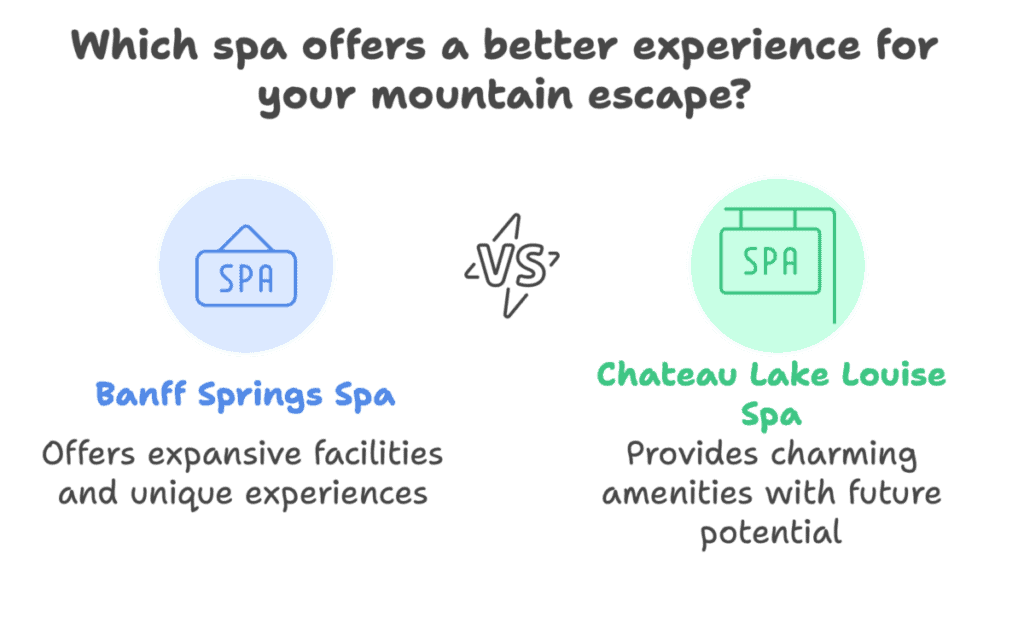
The spa at Château Lake Louise is perfectly lovely, but smaller and less elaborate. It offers all the standard treatments and a decent indoor pool with whirlpool, but no outdoor pool (they closed the old one to make space for spa expansion).
The gym was recently renovated, though, and they’re building a new thermal wellness bath at the lakeshore, planned to open this summer (2025).
If spa time is a priority for your mountain escape, Banff Springs currently has the edge. That said, Lake Louise’s forthcoming outdoor thermal pool overlooking the lake might change the equation once completed.
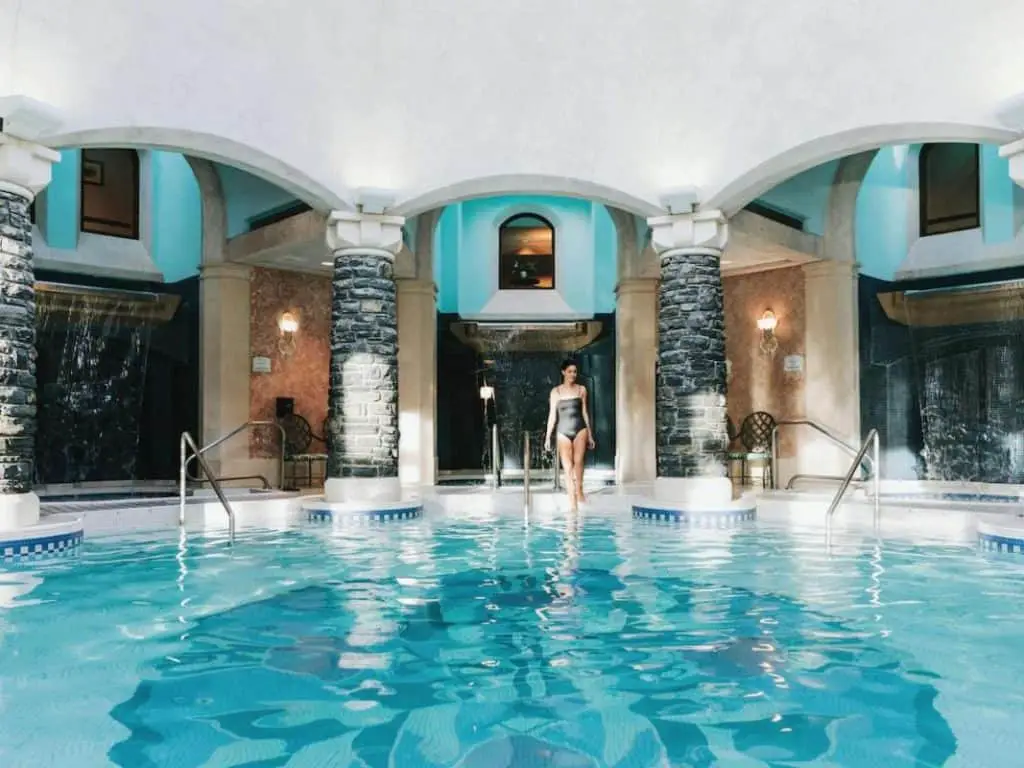
The Money Question
Let’s talk numbers, because these places aren’t cheap. Both hotels command premium rates, but Château Lake Louise consistently prices higher than Banff Springs for comparable rooms — those lake views come at a premium.
Standard rooms at Banff Springs typically start around $30-50 less per night than at Lake Louise, though prices fluctuate wildly by season.
Both properties pile on the extra charges too: parking runs $35-50 per night, resort fees add another $15-20, and taxes push the final bill well beyond the advertised rates.

If you’re getting sticker shock, remember that these are among the most famous hotels in Canada. You’re not just paying for a place to sleep — you’re buying an experience that people save up years for.
That said, value-conscious travelers might prefer Banff Springs. The variety of facilities, proximity to town (meaning access to more affordable food options), and slightly lower room rates combine to make it feel like you’re getting more bang for your buck.
Lake Louise is for those who place supreme value on natural beauty and exclusivity. You’re paying extra for that unmatched setting and the privilege of having Lake Louise practically to yourself after the day-trippers leave.
CHECK PRICES AND AVAILABILITY
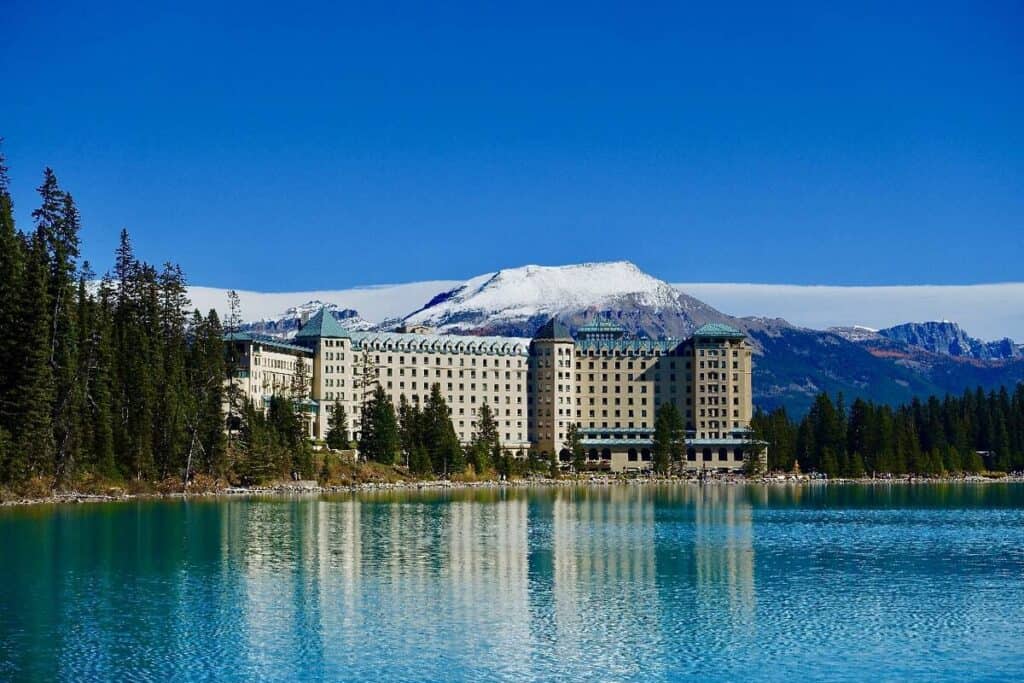
Who Should Stay Where?
There’s no universal ‘better’ choice here — it really depends on what you’re looking for.
Banff Springs shines for:
- Families with kids who need constant entertainment (pools, bowling, arcade, etc.)
- First-time visitors who want to see everything in the area
- People who like having restaurants and shops within walking distance
- Travelers who appreciate a lively, social atmosphere
- Spa enthusiasts who want the full thermal pool experience
- Golfers (in summer)
- History buffs who’ll geek out over the castle’s heritage
Château Lake Louise is ideal for:
- Couples seeking romance and seclusion
- Photographers obsessed with that perfect sunrise shot
- Serious hikers and outdoor enthusiasts
- Winter sports lovers (especially skiers)
- People seeking quiet contemplation in nature
- Anyone for whom “the view” is the main event
The Verdict
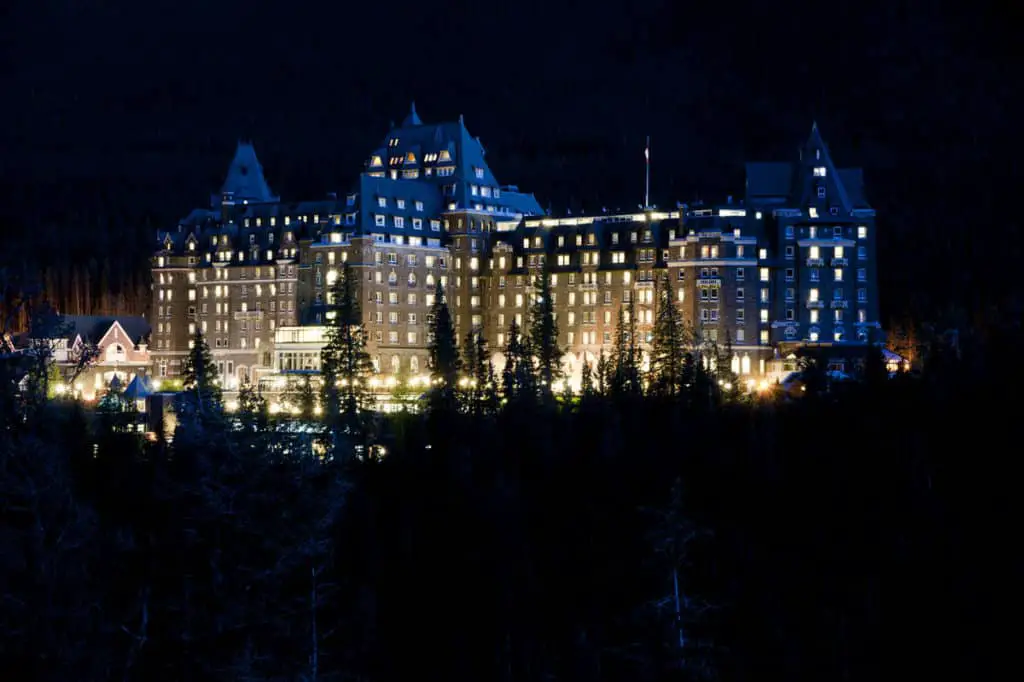
Here’s my take after all this research: if you can swing it, split your stay. Spend a few nights at each hotel to experience both worlds. They’re only about 45 minutes apart by car, so it’s totally doable.
If you can only choose one? Ask yourself what matters more: variety and accessibility (Banff Springs) or natural splendor and serenity (Lake Louise).
Either way, you’ll be staying in a legitimate icon of Canadian hospitality, with service standards that consistently rank these properties among the best hotels in North America. You can’t really go wrong — though your credit card statement might argue otherwise.
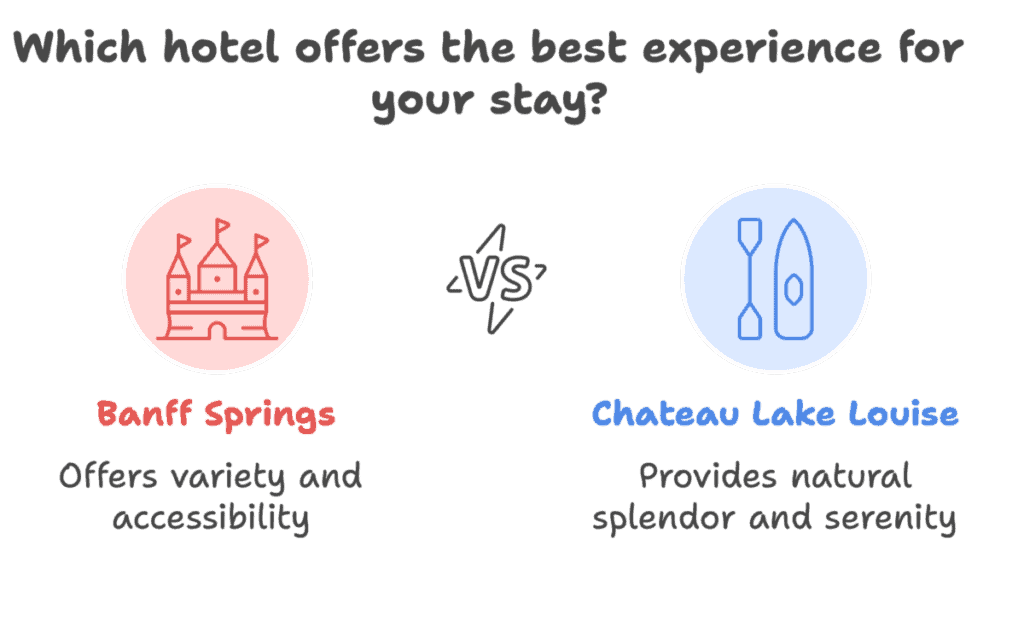
And look… If the prices at either place make you burst out in tears, there are plenty of more affordable options in Banff National Park that still give you access to all that mountain magic. The views are free, even if the luxury bed isn’t.
But if you’re going to splurge on a once-in-a-lifetime Canadian Rockies experience, these two fairy tale castles deliver memories that will last long after the credit card bill is paid.
Just be sure to request a room with a view — you didn’t come all this way to stare at the parking lot…
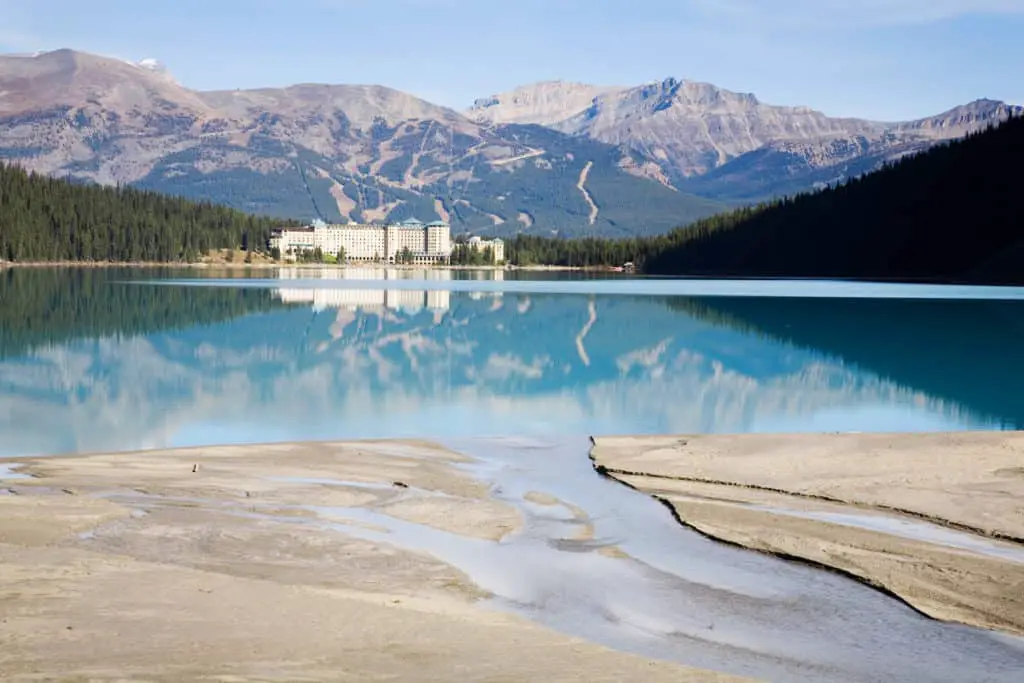
CHECK PRICES AND AVAILABILITY
Banff Travel Guide and FAQ
Where is Banff National Park, Canada?
Banff National Park is in the southwest of the province of Alberta. It’s home to the towns of Banff and Lake Louise and borders the province of British Columbia in the west of Canada. You can easily access famous places like Lake Louise, Moraine Lake, Peyto Lake and the stunning Icefields Parkway from these locations.
Banff and Lake Louise are situated in the Rocky Mountains of Alberta, close to the boundary with British Columbia, as shown on the map of Banff National Park below.https://www.google.com/maps/d/embed?mid=1NZLFEGL3tedVaH8sRqHo3U37urB0dY4&ehbc=2E312F
Is Banff, Canada safe?
Generally speaking, yes. Like most areas, Banff has crime, but it’s still a safe travel place. But Banff has a lot of wildlife, including bears and cougars, so you should always carry bear spray and exercise caution when hiking in the mountains.
What is the best time to Travel to Banff, Canada?
The best time to travel to Banff, Canada, depends on your reason for visiting the park. If you’re going for the stunning nature the park’s famous for, you’d better visit from June to September. The best months to ski are from January through March.
WEATHER IN BANFF, CANADA: AVERAGE TEMPERATURE

The worst months to visit Banff National Park are November, April and May. It’s too chilly to go sightseeing in November, and there isn’t enough snow on the slopes yet. The iconic lakes in the park are still frozen in April and May, and it can still be quite cold.
How do I travel to Banff, Canada?
Want to fly to Banff? Calgary International Airport (Code: YYC) is the closest airport. It’s 130 kilometers (81 mi) to the east of Banff.
Several cities, including Toronto, Chicago, Seattle, and Dallas/Fort Worth, have direct flights into Calgary.
Pick up a rental vehicle at Calgary International Airport, or take a private transport service to your destination. The trip to the park takes about 1 hour and 40 minutes.
Viator has several good options. Click the link to check the options and latest rates.
Banff Car Rental
Want to rent a car during your stay in Banff National Park? Rent one at Calgary International Airport or in the city of Calgary. Yep, there are rental firms in Lake Louise and Banff, but as these are small towns, your rental options can be limited.
Avis is a reputable car rental company, which I’ve used many times. Book now with Avis
What do I pack for Banff, Canada?
The time of year will affect what you should bring with you on your trip to Banff, Canada. If you plan to spend your summer vacation in Banff National Park, you should be okay with light-colored, breathable clothing. Bring a few sweaters, too, as Banff’s summer evenings can be chilly. You’re in the mountains, after all.
When visiting in winter, bring a heavy jacket, such as a parka, and other winter clothing, such as warm pants, long underwear, and (fleece) sweaters. Don’t take it lightly because Banff’s wintertime lows can reach well below zero.
Banff Travel Planning Guide
Do I need a visa for Banff?
Most likely not. Citizens of the US, most European countries, Australia and New Zealand don’t need a visa to enter Canada. Not sure? Click the link to see whether you need a visa or not. The typical length of stay in Canada for people with visa-exempt passports is 90 days.
Do I need travel insurance for Banff?
You bet. Feel confident while traveling with a plan from Travel Insurance Master, one of the top names in travel insurance, for just USD 10 on average per day.
What’s the best way to book my Banff accommodation?
If you plan to book a hotel, hostel or bed & breakfast, Booking.com is your best bet. It has the most hotels listed and often offers the best rates.
Do I need to rent a car in Banf?
Absolutely. While Banff is one of the few national parks in North America with a sizeable public transport network, I strongly advise renting a car if you want to make the most of your visit.
Will my phone work in Banff?
It depends. In the towns of Banff and Lake Louise, you should have good to excellent reception. However, in more remote areas, the signal is spotty. In many places, there will be no signal at all.
What’s the best site to buy Banff flights?
If you’re looking for cheap flights to Banff, I recommend Skyscanner. No surprises with suddenly increased rates (for taxes, seats or luggage) upon checkout. What you see is what you get.
